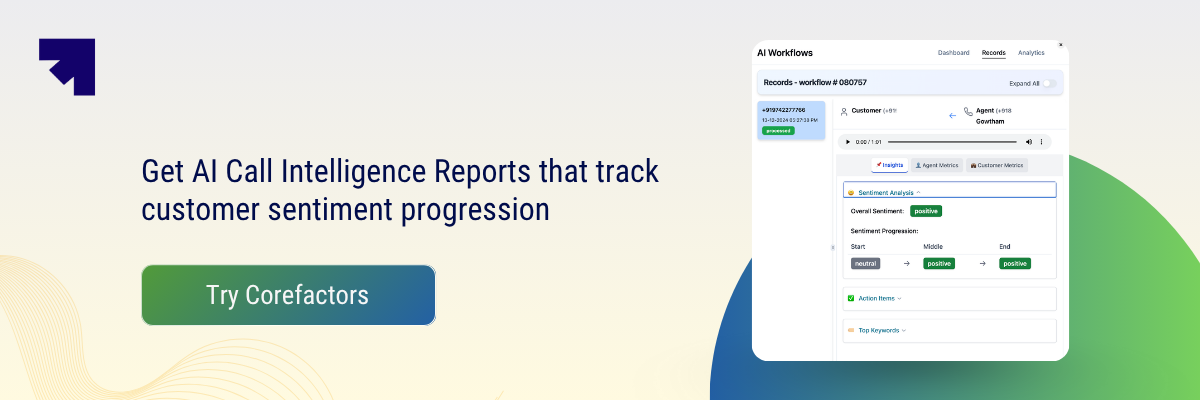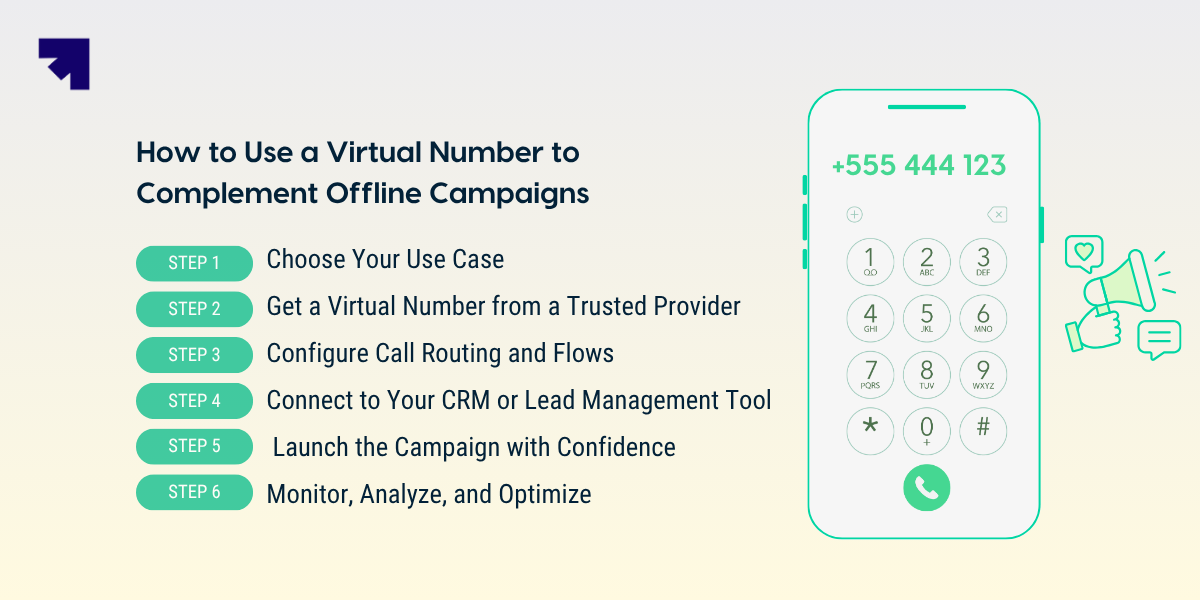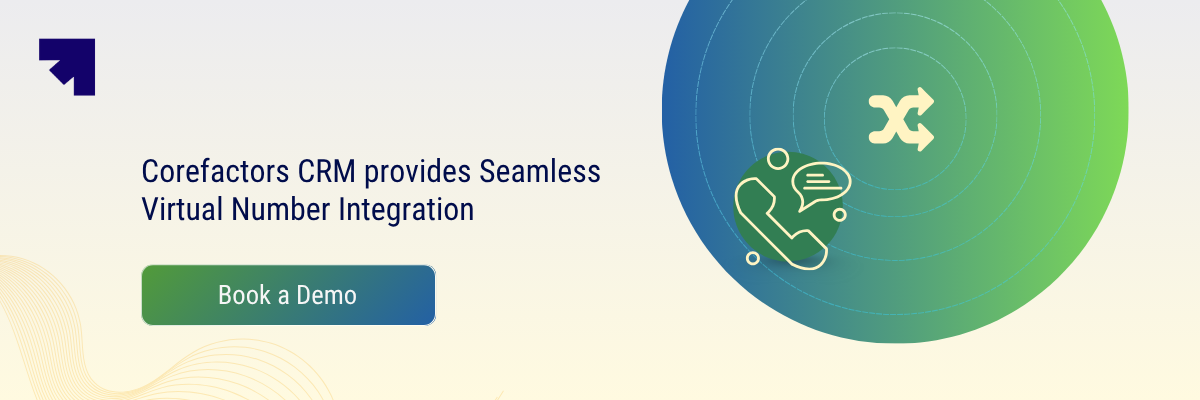Maximizing Offline Campaign ROI with Virtual Number

Heading 1
Heading 2
Heading 3
Heading 4
Heading 5
Heading 6
Lorem ipsum dolor sit amet, consectetur adipiscing elit, sed do eiusmod tempor incididunt ut labore et dolore magna aliqua. Ut enim ad minim veniam, quis nostrud exercitation ullamco laboris nisi ut aliquip ex ea commodo consequat. Duis aute irure dolor in reprehenderit in voluptate velit esse cillum dolore eu fugiat nulla pariatur.
Block quote
Ordered list
- Item 1
- Item 2
- Item 3
Unordered list
- Item A
- Item B
- Item C
Bold text
Emphasis
Superscript
Subscript
Maximizing Offline Campaign ROI with Virtual Number

N Suresh
Join us on November 6th as Mr. Yash Mishra, Product Manager, Fatakpay, reveals the precise strategies that eliminates the speed trap and guarantees a 30% conversion boost.
Offline campaign ROI is one of the hardest metrics to justify, yet it accounts for 44% of total ad spend globally, including print ads, Out Of Home (OOH) advertisements, event sponsorships, and flyers.
You know the calls are coming in. But from where? Which ad? Which channel? Which city? There’s a glaring visibility gap, and that’s costing teams attribution, trust, budget, and performance clarity, unlike digital campaigns.
This is where virtual number marketing flips the script. It assigns unique, trackable virtual numbers to each offline campaign asset, be it a billboard, print insert, radio mention, or event banner you create, to track touchpoints that work just like Urchin Tracking Module (UTM)s do for digital. So now, every call can be a data point with a clear origin and finally connected to the real revenue generated.
In this blog, we’ll unpack how virtual tracking numbers can transform offline marketing from a blind spend to a data-backed growth engine.
What Are Virtual Numbers and How to Track Them?
A virtual number is a cloud-based phone number not linked to a physical phone line, used to route calls intelligently and track their origin.
While every digital click is tracked to the decimal, offline calls still show up as an unknown source. For marketers striving to prove the ROI of offline campaigns, Virtual numbers bridge that gap, acting as the UTM tags of the physical world.
Accurate marketing measurement is critical to proving offline campaign ROI. That’s where virtual numbers come in, as they can be the UTMs of offline marketing.
These smart numbers dynamically forward calls to your sales or support team while silently telling you exactly which ad, location, or campaign drove the call. It looks just like any other number to your audience, but to your marketing team, it’s a goldmine of attribution data.
They work like invisible sensors across your offline marketing assets, and every time a customer dials in, the system captures the source, logs the call, and optionally routes it smartly via Interactive Voice Response (IVR), triggers CRM workflows, or even pushes the lead into your marketing funnel.
How to Track Virtual Numbers?
Mentioned below are the different ways in which you can track virtual numbers.
1. Campaign Tracking
When you assign a unique virtual number to each offline asset, whether it’s a billboard in Bengaluru, a newspaper insert in Delhi, or a brochure handed out at an expo, and a prospect dials that number, the system:
- Forwards the call to your sales or support line
- Logs where, when, and which campaign triggered the call
- Captures caller details and basic call metadata
Each number acts like a tracking pixel, creating a clear campaign-level call trail. So with dedicated lines, there’s zero ambiguity in knowing which channel delivered.
2. Call Analytics
Once the calls start coming in, the real value lies in call analytics. Modern platforms provide deep insights like:
- Call duration
- Call time and geography
- Answered vs missed
- Repeat callers
Some advanced platforms like Corefactors offers caller sentiment detection and transcript analysis, revealing which campaigns worked and the true level of lead engagement.

3. CRM Integration
Some platforms integrate directly with your CRM, so every inbound call becomes a lead with context:
- Every call is auto-converted into a lead, tagged with its source campaign
- Recordings, notes, and lead disposition are captured in one unified view
- End-to-end visibility into the customer journey, from offline touchpoint to closed deal
This bridges the gap in lead tracking, enabling precise attribution and real offline campaign ROI, with no more messy spreadsheets or guesswork.
Corefactors captures every conversation, auto logs it into your CRM, and instantly triggers the next best move, so no leads slip through the cracks.
How Virtual Numbers Maximize Offline ROI
Marketers have always believed in the power of offline marketing. But belief alone doesn’t satisfy a CFO or a performance dashboard. To prove your billboard, radio ad, or print insert drove real revenue, you need clear visibility.
Virtual number marketing closes this gap, turning offline efforts from a brand play into a measurable, scalable acquisition channel.
1. Unique Numbers for Each Campaign Channel
Assigning unique virtual numbers to every offline asset is foundational for tracking, but the real power lies in what you do with that data.
With distinct numbers per billboard, print ad, radio spot, or event, you gain granular visibility into each channel’s performance beyond mere raw call counts to comparable metrics that drive budget and strategy.
For example:
- If your radio campaign’s number drives longer, more qualified calls than print ads, you can confidently shift more spend to radio.
- If certain event locations underperform in call volume or conversion quality, you can identify wasted spend and optimize or reallocate accordingly.
This data-driven approach transforms offline marketing into a precision investment.
2. Gathering Rich Call Metrics
In traditional offline marketing, a spike in call volume is encouraging but not always actionable. Virtual number platforms deepen this data into actionable intelligence by tracking:
- Answered vs. missed calls, pinpointing where leads are lost in real time
- Call duration, measuring engagement from seconds to minutes
- Geographic distribution, identifying if calls come from Tier 1 or Tier 2 cities
With advanced setups, you even get:
- Call transcripts and keyword detection
- Sentiment scoring
- Agent performance benchmarking
This transforms call data into an asset that's a real-time performance dashboard.
3. Calculating Lead Value and Channel ROI
Virtual numbers unlock the true value of your calls by linking leads to revenue. You can:
- Tie each phone lead to a sales rep, a funnel stage, and final revenue
- Map Customer Lifetime Value (LTV) and Customer Acquisition Cost (CAC) by channel
- Benchmark cost-per-lead for offline channels, just like Google or Meta Ads
So instead of saying, “Our print ad brought in 120 calls,”
You say, “Our newspaper campaign generated ₹4.6L in pipeline with a 3.1x ROI and 38% lower CAC.”
This clarity shifts offline marketing from an awareness cost to a direct revenue driver.
4. CRM Integration
The difference between call logging and call intelligence lies in CRM integration. With the right setup:
- Each inbound call becomes a CRM lead, tagged by campaign, date, channel, and engagement
- Sales reps are auto-assigned, follow-ups tracked, and no lead goes cold
- Lead stage updates, reminders, call notes, and transcripts live in one place
And if your CRM has AI or workflow capabilities like Corefactors’ Leadbox, you can:
- Score leads based on call behavior
- Trigger workflows, such as send an SMS, assign to AE, and notify via Slack
- Analyze conversion paths from offline to closed deal
5. Cross-Channel Attribution Models
Offline leads rarely convert in a linear fashion. They might see a print ad, call in, then convert online days later. Traditional models miss this multi-touch journey.
By pairing virtual numbers with UTMs, promo codes, custom fields, or cookies, you connect every touchpoint, turning offline calls into trackable leads across the funnel.
Virtual Number Marketing Best Practices
Virtual numbers are only as powerful as the system behind them. To turn offline campaigns into scalable, revenue-aligned engines, you need a structured strategy, intelligent analytics, and compliance beyond mere number assignment. Here are 7 best practices for it :
1. Designing Virtual Number Campaigns: Assign a unique number to each offline asset, like print, OOH, radio, events, tag it with campaign details, and set routing logic, e.g., local reps for local numbers. Use separate numbers for A/B testing creatives to gain regional insights.
2. Ensuring Data Quality and Privacy Compliance: Stay compliant with Digital Personal Data Protection Act (DPDP - India), General Data Protection Regulation (GDPR - EU), and Telephone Consumer Protection Act (TCPA - US) by securing call recordings, enabling role-based access, and managing opt-ins transparently.
3. AI-Powered Insights and Call Analytics: Track call transcripts, keywords, sentiment progression, and agent-caller dynamics to segment leads, coach reps, and improve conversions. For hybrid campaigns, DNI shows numbers based on sources, like QR code or UTM parameters, campaign, or time, maintaining attribution across touch points.
5. Dashboards for Campaign Management: Get campaign-level insights, real-time alerts, and performance filters via a unified dashboard.
6. Enable Multi-Channel Support: Combine voice, SMS, and WhatsApp from one number for seamless, responsive engagement.
7. IVR Integration: Configure IVRs to qualify leads, capture promo codes, route regionally, and recover missed calls, all without developer support.

How to Use a Virtual Number to Complement Offline Campaigns
Setting up a virtual number is easier than you think, and it instantly upgrades your offline campaigns from relying on guesswork to being growth-ready. Whether you're promoting through billboards, flyers, newspaper ads, or even event kiosks, a virtual number gives each asset a direct, trackable connection to your sales funnel.
Here’s how to get started in just a few steps:

Step 1: Choose Your Use Case
Start by identifying where and why you want to use a virtual number:
- Print ad in a magazine?
- Regional OOH campaign?
- Expo lead capture hotline?
Each of these deserves its own number, and that’s where attribution begins.
Step 2: Get a Virtual Number from a Trusted Provider
Once you’ve mapped your campaigns, choose a cloud telephony or virtual number provider that offers:
- Instant number provisioning. It can be local or toll-free, based on your audience
- Scalability to manage multiple campaigns simultaneously
- Built-in support for call routing, IVR, and CRM integration
Typically, the process involves:
- Selecting your preferred number type based on geography, nationality, or vanity
- Tagging the number to your campaign name or channel
- Defining default routing rules and fallback options
Numbers are usually activated within minutes, ready to go live on your ad creatives, brochures, banners, or booths. Most providers offer a self-serve dashboard or onboarding support to get started.
Tip: Choose providers that allow you to label and manage your numbers by campaign; this makes reporting and optimization easier.

Step 3: Configure Call Routing and Flows
Now, decide what happens when someone dials the number:
- Route calls to specific sales reps, teams, or regions based on geography or campaign logic
- Set working hours and fallback logic, for example, if someone calls after-hours redirect to voicemail or SMS
- Add IVR flows if needed, e.g., “Press 1 for Sales, 2 for Support” to pre-qualify leads or capture promo codes
This step ensures no lead is lost, and calls are routed where they convert best.
Step 4: Connect to Your CRM or Lead Management Tool
To make your virtual number data actionable:
- Sync call data with your CRM or lead management platform
- Automatically create or update lead profiles when a call happens
- Capture campaign name, call metadata, such as time, duration, call outcome, and caller ID
- Trigger follow-up actions like SMS, email, or rep assignment
This is where offline call data turns into structured lead insights and is ready for scoring, nurturing, and reporting.
Step 5: Launch the Campaign with Confidence
Once set up:
- Embed the virtual number on your creative assets
- Ensure the number matches the region or audience preference, e.g., maintain a local feel for print and toll-free for national radio
- Educate internal teams on the campaign flow, especially if using IVR or routing logic
You’re now live with tracking built in from day one.
Step 6: Monitor, Analyze, and Optimize
Use your dashboard or CRM to review:
- Total and missed call volume per campaign
- Call durations, peak hours, and geographic spread
- Lead conversion outcomes from each number
- Which channels are delivering high-quality, sales-qualified calls
Based on this data, pause low-performers, scale high-converting regions, or test new creatives with fresh numbers.
How to Measure the Success of Virtual Number Marketing?
Virtual numbers turn every offline touchpoint into a trackable, data-rich asset, enabling you to measure what matters.
- Call Volume: Tracks how many leads each virtual number drives per asset (print, radio, OOH).
- Call Duration: Reveals lead quality. Longer calls often mean higher interest from better-targeted campaigns.
- Call Source: Tells you which channel or region each number is tied to, enabling granular attribution.
- Conversion Rate: Measures how many calls turn into qualified leads or deals per number/campaign.
- ROI: Quantifies revenue generated from each virtual number, proving offline impact.
- Cost Per Lead (CPL): Shows how efficiently each campaign source performs.
- Bounce Rate: Highlights numbers with high missed or dropped calls and signals poor targeting or rep response.
- Customer Acquisition Cost (CAC): Helps you compare the cost of acquiring paying customers from virtual call sources vs. digital.
How Corefactors Helps Maximize Offline Campaign ROI with Virtual Numbers
Corefactors’ virtual number solution is purpose-built to turn traditional offline channels into measurable, revenue-driving assets. Here’s how it empowers marketers from lead capture to ROI reporting:
1. Smart Call Routing and Smart IVR
Calls are routed dynamically based on geography, time, or caller intent, ensuring prospects connect with the right team or agent. And with multi-level IVR, you can pre-qualify callers, capture promo codes or campaign IDs, set up fallback flows to voicemail or SMS for after-hours coverage.
2. Unlimited Concurrent Calls
Avoid missed opportunities. Corefactors enables unlimited inbound or outbound call capacity during peak campaign periods, ensuring every campaign-generated lead successfully connects.
3. AI-Powered Call Intelligence
Every call is recorded and analyzed for improved phone marketing campaigns. Corefactors automatically transcribes conversations, conducts sentiment analysis, flags call quality, and extracts intent and keyword insights, allowing teams to optimize campaigns and coaching in real time.
4. Advanced Telephony Insights
Trackable metrics like call logs, duration, missed vs. answered rate, and location analytics are visualized in intuitive dashboards, delivering performance clarity across campaigns, numbers, and channels.
5. Number Masking for Privacy and Security
Ensure compliance and trust by masking real numbers. Only the virtual number is visible to callers, helping prevent agent theft or data leakage.
6. Seamless CRM Integration
Call data is pushed directly into your CRM:
- Leads are auto-created and tagged with campaign metadata
- Call recordings, transcripts, dates, and durations logged
- Follow-up workflows triggered automatically (e.g., SMS or task reminders)
This eliminates manual data entry and ensures full offline-to-pipeline attribution.
7. Unlimited Scalability & Concurrent Campaigns
Multiple virtual numbers can be provisioned instantly, which is ideal for managing overlapping campaigns across regions or asset types. With unlimited channels, there's zero flux during peak periods.
8. Flexible Plans Tailored to Your Channel Needs
Choose from local numbers, toll-free 1800/1860 series, or regional mobile numbers, based on your target audience. This flexibility allows optimal campaign alignment with user familiarity and trust.
9. Unified Across Sales, Marketing, and Support
Because it's integrated deeply into the RevOps stack, the same virtual numbers and call data are used across teams:
- Marketers analyze campaign performance
- Sales teams follow up with context
- Support fields troubleshooting, all from the same numbers, same data flow .
By combining AI-driven call analytics, secure routing, CRM integration, and scalable provisioning, Corefactors transforms virtually invisible offline channels into:
- Clear lead sources
- Defined conversion paths
- Tangible ROI metrics
All while reducing manual work, enhancing compliance, and improving lead quality.
Before vs After: Virtual Number Integration for Offline Campaigns
Offline marketing often feels like flying blind with budget spent, results hoped for, but rarely proven. This table breaks down how virtual number integration transforms that uncertainty into precise, actionable offline campaign ROI insights.
| Offline Campaign Element | Without Virtual Numbers | With Corefactors Virtual Numbers |
|---|---|---|
| Call Tracking | No visibility into which asset drove the call | Each number is uniquely linked to campaigns |
| Lead Attribution | Leads remain disconnected from the source channel | Calls auto-tagged by campaign & synced into CRM |
| Performance Analysis | Guesswork based on lead feedback or gut instinct | Dashboards show real-time call volume, duration, source, and conversions |
| Sales Follow-up | Manual lead entry causes delays, errors, and leaks | Auto lead creation + call recording + scoring synced to sales workflows |
| Missed Calls | Lost forever, no visibility | Smart routing + alerts + missed-call recovery SMS |
| Data Compliance & Privacy | Agent phone numbers exposed, no audit trails | Number masking + secure call storage + audit-ready access controls |
| Campaign ROI | Difficult to calculate offline ROI with confidence | Track CPL, CAC, and revenue tied to each campaign asset |
| Marketing–Sales Handoff | Misalignment, blame game | Unified source of truth for calls, lead actions, and outcomes |
| Channel Testing | No structured A/B testing | Assign different numbers to different assets for clear comparative insights |
| Scalability | Scaling comes with chaos, more reps, more guesswork | Unlimited concurrent campaigns |
Bring ROI Clarity to Every Offline Campaign
Offline marketing doesn’t have to be a shot in the dark. Just like your digital clicks, your offline campaigns deserve the same accountability. With virtual number integration, you gain real-time visibility, multi-channel attribution, and hard data to back every rupee spent on your every hoarding, flyer, and event booth, and create ROI clarity.
If you're ready to close the loop between awareness and revenue, assign, track, convert, report, and watch your offline ROI accelerate with Corefactors.

Heading 1
Heading 2
Heading 3
Heading 4
Heading 5
Heading 6
Lorem ipsum dolor sit amet, consectetur adipiscing elit, sed do eiusmod tempor incididunt ut labore et dolore magna aliqua. Ut enim ad minim veniam, quis nostrud exercitation ullamco laboris nisi ut aliquip ex ea commodo consequat. Duis aute irure dolor in reprehenderit in voluptate velit esse cillum dolore eu fugiat nulla pariatur.
Block quote
Ordered list
- Item 1
- Item 2
- Item 3
Unordered list
- Item A
- Item B
- Item C
Bold text
Emphasis
Superscript
Subscript
Frequently Asked Questions (FAQs)
What is offline campaign ROI and why is it hard to measure?


Offline campaign ROI refers to the return on investment from non-digital efforts like print or outdoor ads. It's hard to measure because traditional offline assets don’t track lead origin or engagement natively.
How does virtual number marketing help improve offline campaign ROI?


Virtual number marketing enables unique call tracking for each offline asset, helping marketers tie inbound calls to specific campaigns and prove ROI with real data.
Can I track offline marketing performance in real time?


Yes. With virtual number marketing, you can monitor offline marketing campaigns in real time like tracking call volume, geography, and conversion directly from your CRM dashboard.
How does call tracking impact offline campaign ROI?


Call tracking adds measurable touchpoints to your offline efforts, allowing you to compare asset-level performance and calculate ROI based on actual lead behavior.





















.png)




.png)